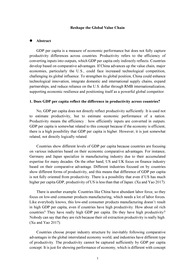

-
미리보기
소개
해외MBA 재학 중이며, 이번 학기 과제로 제출한 리포트입니다.목차
1. Does GDP per capita reflect the difference in productivity across countries?
2. What would be the impact on other major economies if China moves up along the value chain?
3. What should China do about it?
4. References본문내용
Abstract
GDP per capita is a measure of economic performance but does not fully capture productivity differences across countries. Productivity refers to the efficiency of converting inputs into outputs, which GDP per capita only indirectly reflects. Countries develop based on comparative advantages. If China advances up the value chain, major economies, particularly the U.S., could face increased technological competition, challenging its global influence.참고자료
· Jianwei Xu and Yang Yao, International Division of Labor and Global Imbalances, Working Paper, Peking University, 2017.
· M S Mohanty and Philip Turner, Foreign Exchange Reserve Accumulation in Emerging Markets: What are the Domestic Implications? BIS Quarterly Review, September 2006, 39-52.
· Xiaochuan Zhou, Reform the International Monetary System, 2009.
· Marvin Goodfriend and Eswar Prasad, A Framework for Independent Monetary Policy in China, IMF working paper, 2006
· Justin Yifu Lin, Shahrokh Fardoust, and David Rosenblatt, Reform of the International Monetary System, Policy Research Working Paper, 2012, World Bank.태그
-
자료후기
-
자주묻는질문의 답변을 확인해 주세요

꼭 알아주세요
-
자료의 정보 및 내용의 진실성에 대하여 해피캠퍼스는 보증하지 않으며, 해당 정보 및 게시물 저작권과 기타 법적 책임은 자료 등록자에게 있습니다.
자료 및 게시물 내용의 불법적 이용, 무단 전재∙배포는 금지되어 있습니다.
저작권침해, 명예훼손 등 분쟁 요소 발견 시 고객센터의 저작권침해 신고센터를 이용해 주시기 바랍니다. -
해피캠퍼스는 구매자와 판매자 모두가 만족하는 서비스가 되도록 노력하고 있으며, 아래의 4가지 자료환불 조건을 꼭 확인해주시기 바랍니다.
파일오류 중복자료 저작권 없음 설명과 실제 내용 불일치 파일의 다운로드가 제대로 되지 않거나 파일형식에 맞는 프로그램으로 정상 작동하지 않는 경우 다른 자료와 70% 이상 내용이 일치하는 경우 (중복임을 확인할 수 있는 근거 필요함) 인터넷의 다른 사이트, 연구기관, 학교, 서적 등의 자료를 도용한 경우 자료의 설명과 실제 자료의 내용이 일치하지 않는 경우
찾으시던 자료가 아닌가요?
지금 보는 자료와 연관되어 있어요!
문서 초안을 생성해주는 EasyAI



